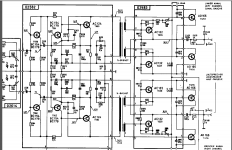Please describe what it is..
And where it is available.
Here temperature controllers use one of the junctions in a BC547 transistor as the cold junction.
Cheap, and reliable in mass production.
If it fails, which is rare, easy to replace.
And where it is available.
Here temperature controllers use one of the junctions in a BC547 transistor as the cold junction.
Cheap, and reliable in mass production.
If it fails, which is rare, easy to replace.
I ment if anyone saw or considered a superdiode circuit based on germanium transitors to compensate a germanium output stage in an amplifier .
Germanium transistors are quite imperfect devices, very lossy; voltage across junctions will follow standard behaviour, although the constant will be different than the silicon one (2mV/°C) and that´s the useful part, but whole transistor will be lossy and pass important current which in pronciple is a quite undocumented parameter (n0ncurves available in general) so I fear that will throw compensation off, big time.
Traditional (and I learnt that in the 60s at the University, lost details long ago) was to use thermistors, you solve for 2 heatsink temperatures, say "ambient" (25-30 °C) and "hot" (say 70°C) and hope it reasonably tracks in between (which it usually does).
Since you "build your own curve", you can compensate as needed; "just thermal diode drop" is not enough.
Traditional (and I learnt that in the 60s at the University, lost details long ago) was to use thermistors, you solve for 2 heatsink temperatures, say "ambient" (25-30 °C) and "hot" (say 70°C) and hope it reasonably tracks in between (which it usually does).
Since you "build your own curve", you can compensate as needed; "just thermal diode drop" is not enough.
@OldDIY i think i know what you mean, circumventing the hfe factor of a transistor this way.
@JMFahey just realized that a friend of mine sent me a simmetric superdiode based schematic of his Korting amplifier which he found sounding as well as his other Hiraga clone...
@JMFahey just realized that a friend of mine sent me a simmetric superdiode based schematic of his Korting amplifier which he found sounding as well as his other Hiraga clone...
Attachments
Dear OldDiy: your NPN example IS a diode (the BE junction) ; the PNP one is NOT but an OPEN transistor.
It will pass some leakage current, no doubt, but will not behave like a diode and certainly NOT drop "one Diode" voltage (0.25 to 0.35V) by any means.
Hint: the B_C junction is reverse biased.
It will pass some leakage current, no doubt, but will not behave like a diode and certainly NOT drop "one Diode" voltage (0.25 to 0.35V) by any means.
Hint: the B_C junction is reverse biased.
@JMFAHEY reversed biased diode wired transistor have a current gain of 1 which means they will pass the lowest amount of current thay can but that doesn't mean they don't act as temperature sensing devices, it's just they only pass twice the base current.
Last edited:
WHICH Base current? NO base current there, since BE is shorted.
No forward biased junction present in the path to act as a diode of any kind.
A reverse biased diode is an open circuit, period.
That transistor is not diode wired, as shown.
In this case, lossy, but in any case will need lots of voltage to be punctured.
Not sure what you call "current gain" ????????
PS:I am talking olddyi PNP example.
No forward biased junction present in the path to act as a diode of any kind.
A reverse biased diode is an open circuit, period.
That transistor is not diode wired, as shown.
In this case, lossy, but in any case will need lots of voltage to be punctured.
Not sure what you call "current gain" ????????
PS:I am talking olddyi PNP example.
I believe the PNP transistor example in OldDIY's attached picture in post #4 may also conduct current more than the typical leakage current typical for an 'OFF' device depending on how we polarize it, a BJT with C and E swapped around do work in reverse too, but poorer.
Courtesy my own empirical corny experiments, albeit limited to a Silicon NPN device. 🙂
Courtesy my own empirical corny experiments, albeit limited to a Silicon NPN device. 🙂
Germanium Power Devices (run by "Oliver Germanium") made some monster Germanium power rectifiers, possibly as an alternative to Schottky devices. There was a sort of kerfluffle somewhere between the late 70's and early 80's re the reliability of Schottky rectifiers. It was, for hte most part, an application problem rather than a device problem for the most part. Having said that Siemens had some reliability issues due to contaminated solder preforms that hey were using to bond the top contact (the most sensitive) of their high current stud-mount devices.
That is why Germanium was gradually replaced by Silicon.
You are trying to do something long consigned to history...
Go digital, for your needs.
You are trying to do something long consigned to history...
Go digital, for your needs.
In the old days when messing around with germanium devices I used a Ge transistor as a Vbe multiplier for output stages. AC128/176 - used another 128 or 176 (whichever was available) and low value potentiometers - something like 100 ohms IIRC due to the low Vbe's. Also used AC128 for AD161/162 outputs at higher power.
Worked well.
They were generally not used in the very early days of germanium because transistors were a lot more expensive, relatively speaking, then, and thermistors were a lot cheaper.
Worked well.
They were generally not used in the very early days of germanium because transistors were a lot more expensive, relatively speaking, then, and thermistors were a lot cheaper.
- Home
- Amplifiers
- Solid State
- Germanium superdiode
